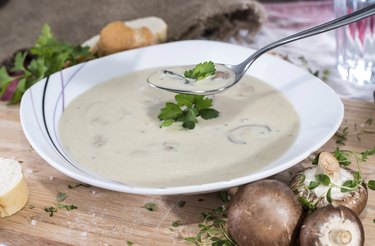
When a recipe calls for cream of mushroom soup, the easy answer is to reach into your pantry and pull out a can. It's convenient and saves time, but it's not very satisfying. With a modest investment in time and effort, you can make your own cream of mushroom soup and freeze it for later use. This leaves you firmly in control of the soup's ingredients and enables you to portion the soup in quantities that make sense for you.
Getting the Logistics Right
Video of the Day
Manage the stove-to-freezer stage properly so that your soup retains good quality and stays food-safe. Your first order of business is to cool the soup quickly to room temperature, which is easiest if you divide it into flat, shallow containers. If you need to cool it in the pot, immerse the pot in a sink filled with ice water and stir it frequently to speed cooling. Wrapping freezer gel packs in clean freezer bags and dropping those right into the soup also helps. Once the soup has cooled, close the containers and distribute them in a single layer around the freezer. For a batch of more than a quart or two, refrigerate half and freeze it the next day.
Video of the Day
Through Thick and Thin
If you appreciate mushroom soup for its own sake, or if your favorite casserole uses it in its reconstituted condition, just freeze it once the batch is finished. Alternatively, if you normally use condensed soup straight from the can, you can replicate that consistency by making a batch with all the thickener but half the liquid. At the other extreme, some cooks choose not to thicken the soup at all before it's frozen. Unthickened soup can be reheated with less risk of scorching, then thickened immediately before serving.
Finessing the Details
If your frozen soup is destined for use in casseroles, measure out 11 fluid ounces per package. That's the equivalent of a standard-sized can. Otherwise, individual half-cup and one-cup portions are the most versatile, because you can thaw as many as you need. Your choice of thickener has some impact on the soup's quality when it's thawed. Mushroom soup thickened with flour or a flour-based roux will be inconsistent and stodgy when thawed, and benefits from stirring and thinning. Cornstarch "weeps" liquid when it thaws. Stirring re-incorporates that moisture, but the starch breaks down slightly and thins the soup. Arrowroot powder and potato starch, two less common thickeners, thaw smoothly.
Some Like it Hot
When it's time to use your frozen soup, don't leave it to thaw on the counter. The outer portion would be in the food-safety "danger zone" for hours, before the middle was defrosted. Whenever possible, thaw your soup overnight in the refrigerator instead. Quick thawing in the microwave is acceptable as well, as long you use the soup right away. If you're going to eat the soup as soup, it must be heated over a very low burner, stirring regularly, to prevent scorching. Heating over a double boiler, or in a microwave at 50 to 70 percent power, avoids that risk.
- University of Georgia Cooperative Extension: Freezing Prepared Foods
- U.S. Department of Agriculture Food Safety and Inspection Service: Freezing and Food Safety
- U.S. Department of Agriculture Food Safety and Inspection Service: The Big Thaw -- Safe Defrosting Methods for Consumers
- Salad In a Jar: Make Your Own Condensed Cream of Mushroom Soup in Less than 5 Minutes